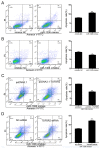miR-1306 Mediates the Feedback Regulation of the TGF-β/SMAD Signaling Pathway in Granulosa Cells
- PMID: 30935128
- PMCID: PMC6523565
- DOI: 10.3390/cells8040298
miR-1306 Mediates the Feedback Regulation of the TGF-β/SMAD Signaling Pathway in Granulosa Cells
Abstract
Transforming growth factor-β receptor II (TGFBR2), the type II receptor of the TGF-β/SMA- and MAD-related protein (SMAD) signaling pathway, plays a crucial role in TGF-β signal transduction and is regulated by multiple factors. Nevertheless, the modulation of the non-coding RNA involved in the process of TGFBR2 expression in ovaries is not well studied. In our study, we isolated and characterized the 3'-untranslated region (UTR) of the porcine TGFBR2 gene and microRNA-1306 (miR-1306) was identified as the functional miRNA that targets TGFBR2 in porcine granulosa cells (GCs). Functional analysis showed that miR-1306 promotes apoptosis of GCs as well as attenuating the TGF-β/SMAD signaling pathway targeting and impairing TGFBR2 in GCs. Moreover, we identified the miR-1306 core promoter and found three potential SMAD4-binding elements (SBEs). Luciferase and chromatin immunoprecipitation (ChIP) assays revealed that the transcription factor SMAD4 directly binds to the miR-1306 core promoter and inhibits its transcriptional activity. Furthermore, the TGF-β/SMAD signaling pathway is modulated by SMAD4 positive feedback via inhibition of miR-1306 expression in GCs. Collectively, our findings provide evidence of an epigenetic mechanism that modulates as well as mediates the feedback regulation of the classical TGF-β/SMAD signaling pathway in GCs from porcine ovaries.
Keywords: TGF-β/SMAD signaling pathway; TGFBR2; granulosa cell apoptosis; miR-1306.
Conflict of interest statement
The authors declare no conflict of interest.
Figures






References
-
- Andl T., Le Bras G.F., Richards N.F., Allison G.L., Loomans H.A., Washington M.K., Andl C.D. Concerted loss of TGFβ-mediated proliferation control and E-cadherin disrupts epithelial homeostasis and causes oral squamous cell carcinoma. Carcinogenesis. 2014;35:2602–2610. doi: 10.1093/carcin/bgu194. - DOI - PMC - PubMed
Publication types
MeSH terms
Substances
LinkOut - more resources
Full Text Sources
Miscellaneous

